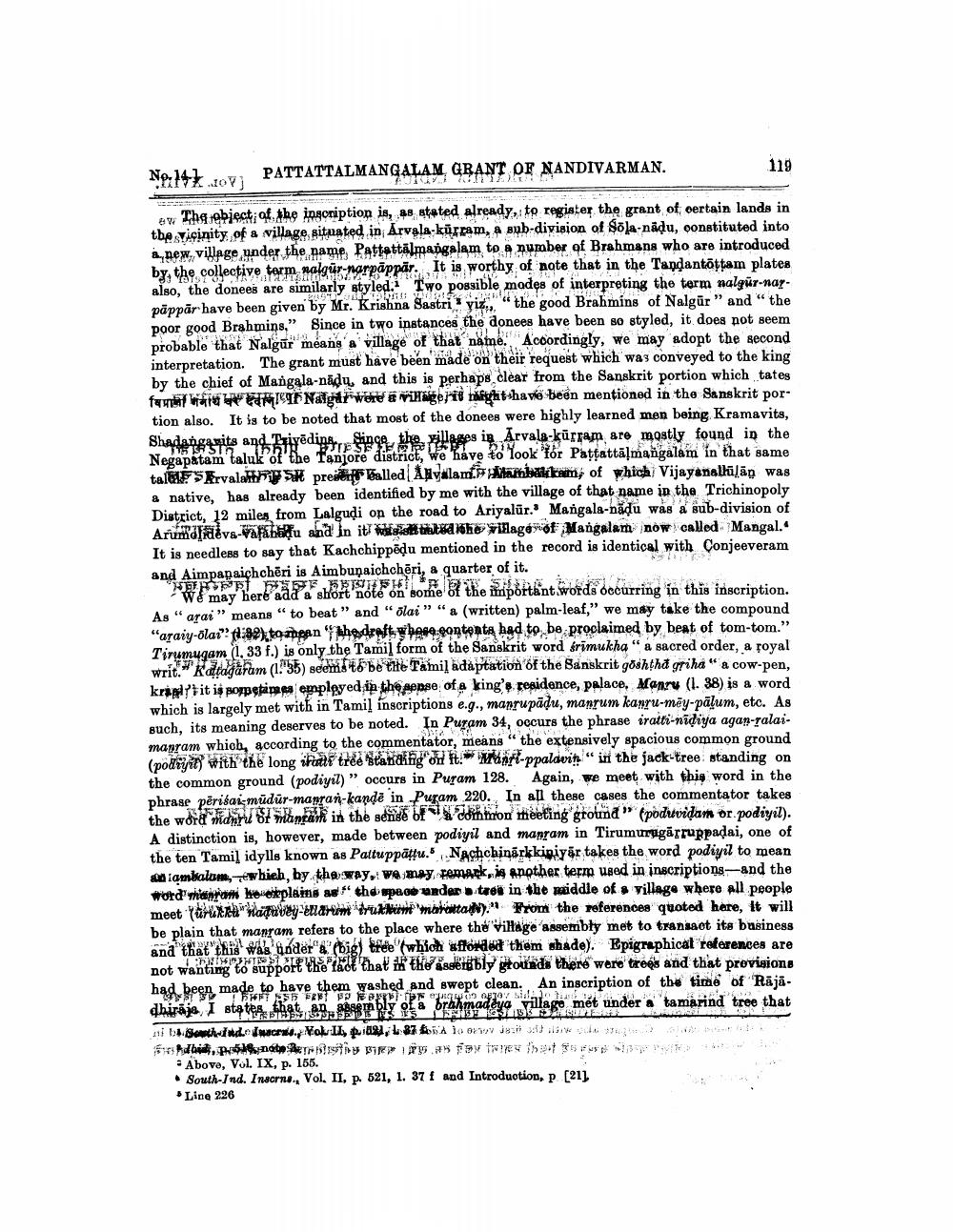________________
No.147.207)
PATTATTALMANGALAM
GRANT OF NA
NANDIVARMAN.
क्षप
33
Brahminste
The object of the inscription is, as stated already, to register the grant of certain lands in the vicinity of a village situated in Arvala-kurram, a sub-division of Sola-nadu, constituted into new village under the name Pat Pattattālmangalam to a number of Brahmans who are introduced by, the collective term nalgur-narpappär. It is worthy of note that in the Tandantōṭṭam plates also, the donees are similarly styled. Two possible modes of interpreting the term nalgur-nar"the good Brahmins of Nalgür" and "the päppār have been given by Mr. Krishna Sastri yiz.,, poor good Since in two instances the donees have been so styled, it does not seem ge of that name. Accordingly, we may adopt the second probable that Nalgur means a village made de on their request which was conveyed to the king interpretation. The grant must have been by the chief of Mangala-nadu, and this is perhaps clear from the Sanskrit portion which tates famalar Nalgar were a village/it might have been mentioned in the Sanskrit portion also. It is to be noted that most of the donees were highly learned men being Kramavits, Arvala-kurram Shadegerits and riding on the illeges in Arvala küram, are mostly found in the for Patṭattāļmangalam in that same taluk of the Tanjore district, we have to Negapatam tal Arvala prea Walled Ames, of which Vijayanaliko was a native, has already been identified by me with the village of that name Trichinopoly a sub-division by
to
was a
miles Lalgudi on the Arumdeva-Vaabu and in it waisted the village of Mangalam now called Mangal. It is needless to say that Kachchippēdu mentioned in the record is identical with Conjeeveram and Aimpanaichcheri is Aimbunaichcheri, a quarter of it.
"c
manram
portant words occurring in this in inscription. We may here add a short note on some As "arai" means to beat" and "ōlai" " a (written) palm-leaf," we may take the compound "araiy-olar" togan "the draft contents had to be proclaimed by beat of tom-tom." Tirumugam (1. 33 f.) is only the Tamil form of the Sanskrit word srimukha" a sacred order, a royal writ. it. Kaltağaram (155) seems to be the Tamil adaptation of the Sanskrit goshtha griha" a cow-pen, kranit is sometimes employed in the sense of a king's residence, palace, Manru (1. 38) is a word which is largely met with in Tamil inscriptions e.g., manrupadu, manrum kanru-mey-palum, etc. As such, its meaning deserves to be noted. In Puram 34, occurs the phrase iratti-nidiya agan-ralaiaccording to the commentator, means "the extensively spacious common ground (podrgny with long stats tree standing on Mant-ppaldvin jack-tree standing on the common ground (podiyil)" occurs in Puram 128. Again, we meet with this word in the phrase perisai-mudur-manran-kande in Puram 220. In all these cases the commentator takes on theeting ground" (poduvidam or podiyil). word manru in the Common A distinction is, however, made between podiyil and manram in Tirumurugaṛruppadai, one of the ten Tamil idylls known as Pattuppattu. Nachchinarkkipiyar takes the word podiyil to mean sambalam, which, by the way, we may remark, is another term used in inscriptions-and the word manram he explains as the space under a tres in the middle of a village where all people meet urut aqubey ellarum trukkum marantady." "From the references quoted here, it will be plain that manram refers to the place where the village assembly met to transact its business and that this was under a (big) tree (which afforded them shade). Epigraphical references are not wanting to support the fact that in the assembly grounds there were trees and that provisions had d been made to have them washed and swept clean. An inscription of the time of Rājā. HET AND BRET FP We as a stage met under a tamarind tree that dhiraja I states that an assembly of a brahmadeya village met 123 13 158192 GSTUS BARUPEES ibSontheinde Juscras., Vok II, p.21, 1875 1o orov Jesi ne vole sug
Adbi, kendte Bettie vir 129.as pay ines that fo ford par my? Above, Vol. IX, p. 155.
South-Ind. Inscrns., Vol. II, p. 521, 1. 37 f and Introduction, p [21] * Line 226
119




